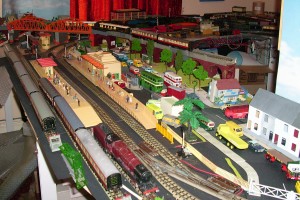This is just excellent advice from David Simmons of use to all 3 rail runners. Fantastic information on points – really useful.
“I’m sorry to hear you are having all these problems. My experience of Dublo track (on and off for almost 60 years) is that it can be very troublesome, but can be beaten. It needs careful laying and only track that has passed rigourous inspection should be used.
A sheet of glass is useful to check that the rails are absolutely flat. Bases with obvious distortion should be either straightened if possible or scrapped. I avoid all track from the Korean war period (card insulators and steel rail are give aways). I also find that mixing wide and narrow tongues can sometimes give problems. The last section of curved rails is often straight, causing doglegs. Careful use of flat nose pliers corrects this – sighting along the rail shows up this one. Duchesses are near their limit on 15″ curves and don’t need any bad joints to worsen matters
Diamond crossings give trouble because the bakelite section in the middle warps (this also happens with uncoupling rails) and there is a bump between this and the metal part File smooth or scrap.
The real problem is, of course, the points, though I have not had particular problems with electric ones (it’s essential to check that the tiny spring underneath holds the point blades firmly over both ways however) . My investigations of these have revealed several problems. Firstly, the gauge through the blades widens to about 18mm. This is why fine scale wheels derail and only wide wheels like Dublo, Lima and later Tri-ang / Tri-ang-Hornby (This stuff is still Tri-ang to me despite usurping the Hornby name!) run through OK. Then, at the other end, the check rails are often bent out of shape and need restoring to their original form, so that the wheels are gently eased into line. Any burrs need removing obviously. Also check that the centre rail is level. Castles, 8Fs and 0-6-2 tanks in particular are prone to the collector shoes getting caught and derailing or shorting and stalling. Again flatness is essential.
I have found that some wheels are out of gauge (the back to back should be 14.2mm). This has to be corrected to avoid problems. A gauge or a vernier/digital caliper is necessary to check.
I’ve waffled on (as usual!) but a last point. To avoid uncoupling, all couplings have to be the same height (I have reserved one wagon with pristine couplings as my standard and all others have to couple and uncouple with this one). The hooks are ideally all the same (original) shape and it is essential that the actual coupling surface is vertical. Level track and attention to these points should mean unwanted uncoupling is rare.
I hope I’ve not stated too much that’s obvious, but I firmly believe in keeping them running rather than decaying away in some collector’s boxes.”
Thank you, David contributions welcome at any time.
Since this post David has sent me a follow up email with some further advice which is very useful and a picture of his now dismantled layout. Another runner, I hope that he gets a new layout soon.
“Hi Tony,
Thanks for your e-mail. Glad to be of assistance and the best of luck with your investigations. I’ve rescued some bad cases in the past., Corrosion and bad wear are the real killers.
The poorer examples can always be used in sidings or the loco depot where speeds are lower anyway. At worst, they can provide spare parts.

I would agree with you about 4MT tank bogies. they’re not quite heavy enough to take the coupling loads, especially with plastic wheels. I was going to try a phosphor bronze spring (like on the West Country), but have never got around to it. I didn’t have much success with the foam. The N2 (I have several of these) has never given bogie problems however. Possibly the axle is bent and the wheels don’t run true?
I’ve attached a photo of my old layout (now dismantled following a move, unfortunately) if you’re interested.
If you need any help don’t hesitate to ask.
Best regards,
David”
